Visit Jamaica and see it for yourself.
See you in Jamaica.
Welcome to the Bonita Jamaica Blog. We are confident that by time you are through reading you will agree that Jamaica is a beautiful place and that Jamaicans are an amazing people. However, until you visit Jamaica, you will not experience the real Jamaican effect. Jamaica is not just a country; we are a revered institution. Add Jamaica to your list of places to visit and tell everyone you know about Bonita Jamaica. See you in Jamaica.
See you in Jamaica.
See you in Jamaica.
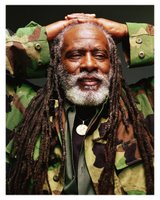 Rodney was born in
Rodney was born in Burning Spear is one of the strongest proponents of Marcus Garvey's self-determination and self-reliance for all African descendants, thus leading to several album releases in commemoration of the African activist.
In 2002, Burning Spear and his wife, Sonia Rodney who has produced a number of his albums, founded Burning Spear Records.
Burning Spear advocates messages of honesty, peace, and love, which tie in with his religious and political messages of Rasta and black unity.
See you in Jamaica.
 Jamaica is a very religious country. We put God first in everything we do. We are very tolerant when it comes to religion but we are not always very friendly to religions that have to do with worshipping the devil or practicing evil. The main religion in Jamaica is Christianity. There is almost an infinite amount of Christian denominations in Jamaica. Walk in any direction and you will run into a place of worship after taking only a few steps.
Jamaica is a very religious country. We put God first in everything we do. We are very tolerant when it comes to religion but we are not always very friendly to religions that have to do with worshipping the devil or practicing evil. The main religion in Jamaica is Christianity. There is almost an infinite amount of Christian denominations in Jamaica. Walk in any direction and you will run into a place of worship after taking only a few steps.THE LORD is my shepherd; I shall not want.
He maketh me to lie down in green pastures; he leadeth me beside the still waters.
He restoreth my soul: he leadeth me in the paths of righteousness for his name's sake.
Yea, though I walk through the valley of the shadow of death, I will fear no evil: for thou art with me; thy rod and thy staff they comfort me.
Thou preparest a table before me in the presence of mine enemies: thou anointest my head with oil; my cup runneth over.
Surely goodness and mercy shall follow me all the days of my life: and I will dwell in the house of the LORD for ever.
Rastafari know what this gathering for
Rastafari know what this gathering for
InI take counsel to trod home a yard
JAH Rastafari know what this ya gathering is for
For in a Mount Zion around JAH throne
I a sight up on the journey fe trod home a yard
For I will never, never turn back
From in a Mount Zion around JAH throne
Rastafari know what this ya gathering for
See you in Jamaica.
 In Jamaica, a Sound System is a popular type of nomadic outdoor concert/party. The sound system scene is generally regarded as an important part of Jamaican cultural history and as being responsible for the rise of modern Jamaican musical styles such as ska and dub.
In Jamaica, a Sound System is a popular type of nomadic outdoor concert/party. The sound system scene is generally regarded as an important part of Jamaican cultural history and as being responsible for the rise of modern Jamaican musical styles such as ska and dub. The sound system concept first became popular in the 1950's, in the ghettos of Kingston. DJs would load up a truck with a generator, turntables, and huge speakers and set up street parties. In the beginning, the DJs played American R&B music, but as time progressed and more local music was created, the sound migrated to a local flavor.
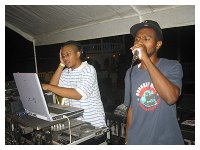
The sound systems were big business, and represented one of the few sure ways to make money in the unstable economy of the area. The promoter (the DJ) would make his profit by charging a minimal admission, and selling food and alcohol. Competition between these sound systems was fierce, and eventually two DJs emerged as the stars of the scene: Clement 'Coxsone' Dodd, and Duke Reid. It was not uncommon for thousands of people to be in attendance.
 The popularity of a sound system was mainly contingent on one thing: having new music. In order to circumvent the release cycle of the American record labels, the two sound system superstars turned to record production. Initially, they produced only singles for their own sound systems, known as "Exclusives" or Dubplates - a limited run of one copy per song.
The popularity of a sound system was mainly contingent on one thing: having new music. In order to circumvent the release cycle of the American record labels, the two sound system superstars turned to record production. Initially, they produced only singles for their own sound systems, known as "Exclusives" or Dubplates - a limited run of one copy per song.
What began as an attempt to copy the American R&B sound using local musicians became Jamaica's first unique music: Ska. As this new musical form became more popular, both Dodd and Reid began to move more seriously into music production. Coxsone Dodd's production studio became the famous Studio One, while Duke Reid founded the famous Treasure Isle.
* Duke Reid - The Trojan
* Coxsone Dodd - Coxsone Downbeat
* King Edwards The Giant
* Sinclair The Lion
* Count Boysie
* Prince Buster
* King Tubby's Hi-Fi
* ARROWS Hi-Fi
* EMPEROR FAITH
* Bells The President
* Lloyd Daley - Lloyd The Matador
* Percival Tibby - Sir Percy
* Percel Chin - Admiral Chin
* Joe Chin - Unitone
* Ken Hamilton - Duke Hamilton
* Roy Muncey - Count Muncey
* Mr Chung - Cavaliers
* King Prof
* Bass Odyssey
* Killamanjaro
* Hoo Kim Brothers - Channel One
* Stone Love Movements
* Harry Mudie - Mudies Hi-Fi
* Socialist Roots Sound System
* Fire Links
* Code Red Sound
* Renaissance Disco
* Sir Coxsone Outernational
* Saxon
* Unity
* Qualitex
* Immortal
* Infinity
* Iration Steppas
* High Pressure
* Symbiosis
* Jah Shaka
* Channel One
* King Earthquake
* Jah Youths
* Freedom Masses
* Aba-Shanti-I
* Jah Voice
* Operation Sound System
* Jah Tubbys
* RDK Hifi
* Toxic Sound System
* Axis Sound System - http://www.axissound.co.uk
* Gladdy wax
See you in Jamaica.
 Robert Nesta Marley,
Robert Nesta Marley, His best known songs are a mixture of reggae, rock, and rhythm and blues, and include "I Shot the Sheriff", made famous in 1974 by Eric Clapton, which raised Marley's international profile, "No Woman No Cry", "Exodus", "Could You Be Loved", "Jamming","Redemption Song" and one of his most famous songs, "One Love". His posthumous album Legend (1984) became the best-selling reggae album ever, with sales of more than 12 million copies.
Early life and career
Bob Marley was born on Tuesday in the small village of Nine Miles in
‘I don't have prejudice against myself. My father was a white and my mother was black. Them call me half-caste or whatever. Me don't dip on nobody's side. Me don't dip on the black man's side nor the white man's side. Me dip on God's side, the one who create me and cause me to come from black and white.’
Marley and his mother moved to
 Young Marley became friends with Neville "Bunny" Livingston (later Bunny Wailer), with whom Marley started to play music. Marley left school at the age of 14 and started as an apprentice at a local welder's shop. In his free time, he and Livingston made music with Joe Higgs, a local singer and devout Rastafarian whom many critics regard as Marley's mentor. It was at one of the jam sessions with Higgs and Livingston that Marley met Peter McIntosh (later known as Peter Tosh), who had similar musical ambitions.
Young Marley became friends with Neville "Bunny" Livingston (later Bunny Wailer), with whom Marley started to play music. Marley left school at the age of 14 and started as an apprentice at a local welder's shop. In his free time, he and Livingston made music with Joe Higgs, a local singer and devout Rastafarian whom many critics regard as Marley's mentor. It was at one of the jam sessions with Higgs and Livingston that Marley met Peter McIntosh (later known as Peter Tosh), who had similar musical ambitions.
In 1962, Marley recorded his first two singles, "Judge Not" and "One Cup of Coffee", with local music producer Leslie Kong. These songs attracted little attention, and were later re-released on Marley's Songs of Freedom album.
In 1963, Bob Marley, Bunny Livingston, Peter McIntosh, Junior Braithwaite, Beverley Kelso, and Cherry Smith formed a ska and rocksteady group, calling themselves "The Teenagers". They later changed their name to "The Wailing Rudeboys", then to "The Wailing Wailers", and finally to "The Wailers". By 1966, Braithwaite, Kelso, and Smith had left The Wailers, leaving the core trio of Marley, Livingston, and McIntosh.
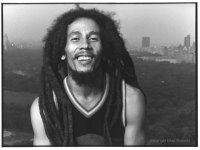 Marley took on the role of leader, singer, and main songwriter. Much of The Wailers' early work, including their first single Simmer Down, was produced by Coxsone Dodd at Studio One. The single topped Jamaican Charts in 1964 and established The Wailers as one of the hottest groups in the country. They followed up with songs such as "Soul Rebel" and "400 Years".
Marley took on the role of leader, singer, and main songwriter. Much of The Wailers' early work, including their first single Simmer Down, was produced by Coxsone Dodd at Studio One. The single topped Jamaican Charts in 1964 and established The Wailers as one of the hottest groups in the country. They followed up with songs such as "Soul Rebel" and "400 Years".
In 1966, Marley married Rita Anderson, and moved near his mother's residence in
After a conflict with Dodd, Marley and his band teamed up with Lee "Scratch" Perry and his studio band, The Upsetters. Although the alliance lasted less than a year, they recorded what many consider The Wailers' finest work. Marley and Perry split after a dispute regarding the assignment of recording rights, but they would remain friends and work together again.
Between 1968 and 1972, Bob and Rita Marley, Peter McIntosh, and Bunny Livingston re-cut some old tracks with JAD Records in
The Wailers' first album, Catch A Fire, was released worldwide in 1973, and sold well. It was followed a year later by Burnin', which included "Get Up, Stand Up" and "I Shot The Sheriff". Eric Clapton made a hit cover of the latter in 1974.
The Wailers broke up in 1974, with each of the three main members going on to pursue solo careers. The reason for the breakup is shrouded in conjecture; some believe that there were disagreements amongst Livingston, McIntosh, and Marley concerning performances, while others claim that Livingston and McIntosh simply preferred solo work. McIntosh began recording under the name Peter Tosh, and
Bob Marley & The Wailers
 Despite the breakup, Marley continued recording as "Bob Marley & The Wailers". His new backing band included brothers Carlton and Aston "Family Man" Barrett on drums and bass respectively, Junior Marvin and Al Anderson on lead guitar, Tyrone Downie and Earl "Wya" Lindo on keyboards, and Alvin "Seeco" Patterson on percussion. The "I Threes", consisting of Judy Mowatt, Marcia Griffiths, and Marley's wife, Rita, performed backup vocals.
Despite the breakup, Marley continued recording as "Bob Marley & The Wailers". His new backing band included brothers Carlton and Aston "Family Man" Barrett on drums and bass respectively, Junior Marvin and Al Anderson on lead guitar, Tyrone Downie and Earl "Wya" Lindo on keyboards, and Alvin "Seeco" Patterson on percussion. The "I Threes", consisting of Judy Mowatt, Marcia Griffiths, and Marley's wife, Rita, performed backup vocals.
In December 1976, two days before "Smile
 Marley left
Marley left
In 1978, Marley performed at another political concert in
The words he said, as he called the two politicians onstage, and while he held their hands above his head:
‘His Imperial Majesty Emperor Haile Selassie I, run lightning, leading the people of the slaves to shake hands. . . To show the people that you love them right, to show the people that you gonna unite, show the people that you're over bright, show the people that everything is all right. Watch, watch, watch, what you're doing, because . . I'm not so good at talking but I hope you understand what I'm trying to say. I'm trying to say, could we have, could we have, up here onstage here the presence of Mr. Michael Manley and Mr. Edward Seaga. I just want to shake hands and show the people that we're gonna unite . . . we're gonna unite . . . we've got to unite . . . The moon is high over my head, and I give my love instead. The moon is high over my head, and I give my love instead.’
He said this while improvising on the song "Jamming".
Uprising (1980) was Bob Marley's final studio album, and is one of his most religious productions, including "Redemption Song" and "Forever Loving Jah". It was in "Redemption Song" that Marley sang the famous lyric,
‘Emancipate yourselves from mental slavery none but ourselves can free our minds...’
Confrontation, released posthumously in 1983, contained unreleased material recorded during Marley's lifetime, including the hit "Buffalo Soldier" and new mixes of singles previously only available in
Religion
Bob Marley was a member of the Rastafari movement, whose culture was a key element in the development of reggae. Bob Marley became the leading proponent of the Rastafari, taking their music out of the socially deprived areas of
Now considered a "rasta" legend, Marley's adoption of the characteristic Rastafarian dreadlocks and famous use of marijuana as a sacred sacrament in the late sixties were an integral part of his persona. He is said to have entered every performance proclaiming the divinity of Jah Rastafari.
Many of Marley's songs contained Biblical references, sometimes using wordplay to fuse activism and religion, as in "Revolution" and "Revelation":
‘Revelation, reveals the truth...’
A few months before his death, Marley was baptised into the Ethiopian Orthodox Church and took the name Berhane Selassie (meaning the Light of the Holy Trinity in Amharic).
Diagnosis
In July 1977, Marley was found to have malignant melanoma in a football wound on his right hallux (big toe). Marley refused amputation, citing worries that the operation would affect his dancing, as well as the Rastafarian belief that the body must be "whole"
‘Rasta no abide amputation. I don't allow a man to be dismantled.’
Marley may have seen medical doctors as samfai, confidence men who cheat the gullible by pretending to have the power of witchcraft [citation needed]. True to this belief Marley went against all surgical possibilities and sought out other means that would not break his religious beliefs.
Collapse and Treatment
The cancer spread to Marley's brain, lungs, liver, and stomach following his refusal of treatment. After playing two shows at
Bob Marley played his final concert at the Stanley Theater in
Death
While flying home from
Children
1. Imani Carole, born
2.
3. Cedella, born
4. David "Ziggy", born
5. Stephen, born
6. Robert "Robbie", born
7. Rohan, born
8. Karen, born 1973 to Janet Bowen;
9. Stephanie, born 1974 to Rita in a separate marriage;
10. Julian, born
11. Ky-Mani, born
12. Damian, born
13. Makeda, born
Posthumous Reputation
Bob Marley's music has continuously grown in popularity in the years since his death, providing a stream of revenue for his estate and affording him a mythical status in 20th century music history. He remains enormously popular and well-known all over the world, particularly so in
In 2001, the same year that Marley won the Grammy Lifetime Achievement Award, a feature-length documentary about his life by Jeremy Marre, Rebel Music, was nominated for the Best Long Form Music Video documentary at the Grammies. It won various other awards. With contributions from Rita, the Wailers, and Marley's lovers and children, it tells much of the story too in his own words.
In February 2006, a
In January 2005, it was reported that Rita Marley was planning to have her late husband's remains exhumed and reburied in
* Apr-Jul 1973: Catch a Fire Tour (
* Oct-Nov 1973: Burnin' Tour (
* Jun-Jul 1975: Natty Dread Tour (
* Apr-Jul 1976: Rastaman Vibration Tour (
* May-Jun 1977: Exodus Tour (
* May-Aug 1978: Kaya Tour (
* Apr-May 1979:
* Oct-Dec 1979: Survival Tour (
* Apr 1980:
* May-Sep 1980: Uprising Tour (
Marley's star on the Hollywood Walk of Fame
* June 1978: Awarded the Peace Medal of the
* February 1981: Awarded
* March 1994: Inducted into the Rock and Roll Hall of Fame
* 1999: Album of the Century for Exodus (Time Magazine)
* February 2001: A star on the Hollywood Walk of Fame
* February 2001: Awarded Grammy Lifetime Achievement Award
* 2005: Posthumous Achievement Award
* "One Love" named song of the millennium by The BBC
Visit Jamaica and see how such legends are created.
Powell is the second Jamaican to win this prestigious award, following in the footsteps of Merlene Ottey, who did same in 1990.
And Chinese star Liu Xiang won the award for the performance of the year for his stunning world record breaking 12.88sec in the 110m hurdles at
|
Ethiopian Meseret Defar took the women's best performance honours for breaking the 5,000m world record in
Powell and Richards were also given a cheque for US$100,000 each.
Their victories were hardly surprising as the pair both went unbeaten throughout the season and shared the Golden League jackpot with American 400m runner Jeremy Wariner.
Powell twice equalled his own 100m record mark of 9.77sec, which he shares with drugs-tainted American Olympic champion Justin Gatlin, who may yet be stripped of his share of the record.
Richards took 15 straight victories at 400m and broke the 22-year-old American record with 48.70sec to become the seventh fastest woman of all time.
"Last year I wanted to win this title, but I didn't because I got injured," said Powell.
Only Liu, who is preparing for the Asian Games, was not in
Other prize winners were
Previous World Athletes of the Year
1988 Carl Lewis (USA) / Florence Griffith-Joyner (USA)
1989 Roger Kingdom (USA) / Ana Fidelia Quirot (CUB)
1990 Steve Backley (GBR) / Merlene Ottey (JAM)
1991 Carl Lewis (USA) / Katrin Krabbe (GER)
1992 Kevin Young (USA) / Heike Henkel (GER)
1993 Colin Jackson (GBR) / Sally Gunnell (GBR)
1994 Noureddine Morceli (ALG) / Jackie Joyner-Kersee (USA)
1995 Jonathan Edwards (GBR) / Gwen Torrence (USA)
1996 Michael Johnson (USA) / Svetlana Masterkova (RUS)
1997 Wilson Kipketer (DEN) / Marion Jones (USA)
1998 Haile Gebrselassie (ETH) / Marion Jones (USA)
1999 Michael Johnson (USA) / Gabriela Szabo (ROM)
2000 Jan Zelezny (CZE) / Marion Jones (USA)
2001 Hicham El Guerrouj (MAR) / Stacy Dragila (USA)
2002 Hicham El Guerrouj (MAR) / Paula Radcliffe (GBR)
2003 Hicham El Guerrouj (MAR) / Hestrie Cloete (RSA)
2004 Kenenisa Bekele (ETH) / Yelena Isinbayeva (RUS)
2005 Kenenisa Bekele (ETH) / Yelena Isinbayeva (RUS)
See you in Jamaica.
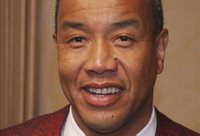 Michael Lee-Chin (1951 - Present) is a Jamaican-Canadian investor. Amongst other positions, he is currently CEO of AIC Limited (a Canadian mutual fund), and Chairman of the National Commercial Bank of
Michael Lee-Chin (1951 - Present) is a Jamaican-Canadian investor. Amongst other positions, he is currently CEO of AIC Limited (a Canadian mutual fund), and Chairman of the National Commercial Bank of Childhood
Lee-Chin was born in Port Antonio in northeast
In 1970 he went to
 He worked briefly as a road engineer for the Jamaican Government, but unable to find work in his qualified field (and allegedly, because his Canadian wife didn't like living in
He worked briefly as a road engineer for the Jamaican Government, but unable to find work in his qualified field (and allegedly, because his Canadian wife didn't like living in
He spent two years at the Investors Group, and in 1979, moved to Regal Capital Planners and became regional manager. Whilst at the company, in 1983, he secured a loan from the Continental Bank of
Performance 1990 – 2005
In the late 1980s, AIC suffered from a collapse in the real estate market, in which it had invested. It recovered throughout the early 1990s by maintaining investments in large groups, such as Merrill Lynch and TD bank (formerly Toronto Dominion). This caused investments to grow from US$8 million in 1990 to nearly US$8 billion by 1998.
 However, Lee-Chin was reluctant to invest in the dotcom boom, and saw AIC investments lose 8 per cent in value, even as the S&P gained 56 per cent. Investors moved US$224 million out of AIC's flagship 'Advantage Mutual Fund'. The Globe and Mail ran an article predicting even more investors to leave the fund, meaning that they would run out of cash and be forced to sell its core holdings. Lee-Chin's response was to sell stock in Coca-Cola, and invest US$65 million into Mackenzie Holdings (the same firm in which he had invested US$400,000 16 years previously). Letters were sent to all 350,000 investors, explaining the strategy. The investors were calmed by the purchase, and the stock was later sold to Investor Group (the same company Lee-Chin had worked for in the 1980s) at more than twice the price AIC had paid for it.[14] In 2000 and 2001, following the dotcom crash, AIC outperformed the market with 26 per cent growth and 4 per cent decline respectively.
However, Lee-Chin was reluctant to invest in the dotcom boom, and saw AIC investments lose 8 per cent in value, even as the S&P gained 56 per cent. Investors moved US$224 million out of AIC's flagship 'Advantage Mutual Fund'. The Globe and Mail ran an article predicting even more investors to leave the fund, meaning that they would run out of cash and be forced to sell its core holdings. Lee-Chin's response was to sell stock in Coca-Cola, and invest US$65 million into Mackenzie Holdings (the same firm in which he had invested US$400,000 16 years previously). Letters were sent to all 350,000 investors, explaining the strategy. The investors were calmed by the purchase, and the stock was later sold to Investor Group (the same company Lee-Chin had worked for in the 1980s) at more than twice the price AIC had paid for it.[14] In 2000 and 2001, following the dotcom crash, AIC outperformed the market with 26 per cent growth and 4 per cent decline respectively.
In 2002, the fund fell again as a result of a regulatory investigation into Amvescap, one of their core holdings. The OSC fined AIC US$58.8 million for their involvement.
On
Private Life
In 1974, he married Vera, a Ukrainian Canadian that he had met at University. They parted in 1991, and officially separated (though did not divorce) in 1997. Ms Lee-Chin has since contested the separation, claiming that Lee-Chin did not disclose his actual wealth at the time of the separation. The couple had three children (Michael Jr, Paul, and Adrian).
Lee-Chin is now in a relationship with Sonya Hamilton, with whom he has had two fraternal-twin daughters. They live in Flamborough.
Current Fund Growth and Difficulties
Investment in
 In the late 1990s and early 2000s,
In the late 1990s and early 2000s,
Commodities Boom
Similar to the experience of the late 1990s, Lee-Chin again has shied away from investing in commodities and the energy market boom. He has specifically stated that "We [AIC] do not like commodities-type businesses nor most high-tech companies simply because they are implicitly poor enterprises which we would not want to hold for the long term".
Again, this strategy has meant that AIC has significantly underperformed the S&P index, but Lee-Chin believes that the current boom is just another bubble. Lee-Chin describes the market since 1990 as 'a series of rolling speculations', and now 'we see a commodities bubble'.
Business Strategy
While at the Investors Group, he studied the strategies of successful investors, such as Warren Buffett, Benjamin Graham and Ken Thomson. Their buy and hold strategy is easily recognisable in the motto of AIC - Buy, hold and prosper.
Accolades and Awards
Lee-Chin has received various business awards, including:
He is also a generous philanthropist, and has donated to various causes, including:
Business Ventures
See you in Jamaica.
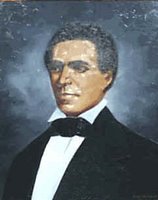 John Brown Russwurm (1799-1851) was an African American abolitionist from
John Brown Russwurm (1799-1851) was an African American abolitionist from Early Life
John Russwurm was born in 1799 in Port Antonio,
That year, his father sent him to a formal school located in
Schooling
After the family's relocation Russwurm attended
Abolitionism
After graduating from college, he moved to
Journalism
The name of the paper was Freedom's Journal. Among all of his writers, he himself had the most articles published. Russwurm always took his time on his articles; to make them as full and lengthy as possible. His paper was the only one in circulation run entirely by African Americans. Of all the abolitionist newspapers, Freedom's Journal was named the most successful. Due to such a high demand, Russwurm and his crew of writers worked late and hard to ship the newspapers all over the
John got a job offer in 1829 for a post in the organization for Pan-Africanism, at the colony of
The first thing that John Russwurm did when he arrived in
Taking on the Post
After his language school, he immediately went to work at his post. Russwurm's new post was located in the
The Ending
Russwurm pushed and stayed strong during his time on post. In 1851, John Russwurm died while still on post. There is a statue of John Russwurm at his burial site at Harper,
See you in Jamaica.
 Garth Fagan is a modern dance choreographer. Born in
Garth Fagan is a modern dance choreographer. Born in
Fagan won a Tony Award for best choreography in 1998 for The Lion King. His work for Lion King also received the Drama Desk Award and the Outer Critics Circle Award that same year.
Fagan is a Distinguished University Professor at the State University of New York at Brockport. In 1989 he received a Guggenheim Fellowship. In 2001 Fagan received the Samuel H. Scripps American Dance Festival Award which honors modern dance choreographers.
In 2001 Fagan received the Samuel H. Scripps American Dance Festival Award which honors modern dance choreographers.
 Alexander James Dallas, statesman, born in the
Alexander James Dallas, statesman, born in the He accompanied an armed force to
After March 1815, he discharged the duties of secretary of war in addition to the direction of the treasury department, and superintended the reduction of the army consequent upon the restoration of peace. Having contributed, to the extent of his ability, to extricate the government from its financial difficulties, and having seen the United States bank firmly established, he retired from office in November 1816, and returned to the practice of law in